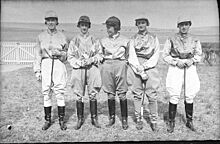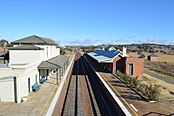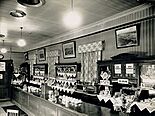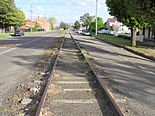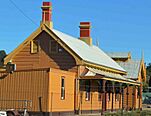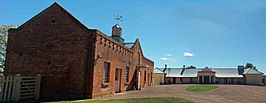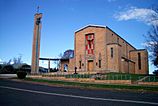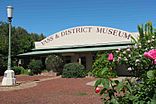Yass, New South Wales facts for kids
Quick facts for kids YassNew South Wales |
|||||||||||||||
|---|---|---|---|---|---|---|---|---|---|---|---|---|---|---|---|
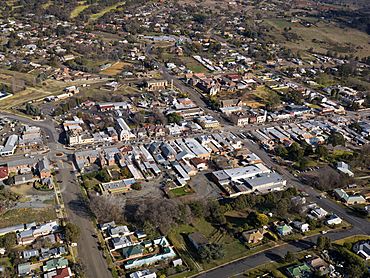
Aerial photograph of Yass
|
|||||||||||||||
| Population | 6,763 (2021 census) | ||||||||||||||
| Established | 1837 | ||||||||||||||
| Postcode(s) | 2582 | ||||||||||||||
| Elevation | 505 m (1,657 ft) | ||||||||||||||
| Location | |||||||||||||||
| LGA(s) | Yass Valley Council | ||||||||||||||
| Region | Southern Tablelands | ||||||||||||||
| County | Murray | ||||||||||||||
| Parish | Hume | ||||||||||||||
| State electorate(s) | Goulburn | ||||||||||||||
| Federal Division(s) | Eden-Monaro | ||||||||||||||
|
|||||||||||||||
Yass (/jæs/) is a town in New South Wales, Australia. It is located where the Southern Tablelands and South West Slopes meet. The name "Yass" comes from an Aboriginal word, "Yarrh," which means 'running water.'
Yass is about 280 kilometers (174 miles) southwest of Sydney on the Hume Highway. It is also only 59 kilometers (37 miles) from Canberra. The town sits 505 meters (1,657 feet) above sea level. The Yass River, which flows into the Murrumbidgee River, runs through the town.
Yass has a historic main street called High Street. Many of its old 19th-century buildings with verandahs are still there. It is a popular spot for tourists. Some visitors come from Canberra, while others stop for a break from driving on the Hume Highway.
Contents
History of Yass
Aboriginal History
The Ngunawal tribe lived in the area around Yass for a very long time. They called the area yarrh, meaning "running water." When Europeans heard this word, they wrote it as "Yass." This was because the "rr" sound was strong and sharp, making it sound like a double-S.
European Settlement
Europeans first saw the Yass area in 1821. This was during an expedition led by Hamilton Hume. By 1830, people started to settle where the road from Sydney to Melbourne crossed the Yass River. The town site was officially marked out in 1837.
Yass became a District Council in 1843. By 1848, it had a population of 274 people. On March 13, 1873, Yass became a Municipal District. James Cottrell was then chosen as the first Mayor of Yass.
Two famous Australian poets have links to Yass. A.B. 'Banjo' Paterson moved to the area in 1871 when he was seven. He spent his childhood there. Later, he bought a property near Wee Jasper so his own children could experience country life. Poet and priest Patrick Hartigan (who wrote as John O'Brien) was born near Yass in 1878. He went to school at the local convent.
Sir Walter Merriman started 'Merryville' in 1903. This became one of Australia's most famous sheep farms. It was known for producing very fine wool. Yass is still an important area for raising sheep because of its good soil and climate.
After 1901, Yass was considered as a possible place for Australia's capital city. However, Canberra was chosen instead. The proposed site for the capital would have been just west of Yass.
In 1956, Yass was the first town in New South Wales to have fluoridated water. The Hume Highway used to go through the town. But a bypass road was opened in July 1994, taking traffic around Yass.
Flour Mills in Yass
Yass was home to several flour mills, even though the area is famous for fine wool. Some mills were likely set up for families to grind their own grain. Others were for business.
In March 1842, the Yass Steam Mill started working. It was owned by Hamilton Hume and John Watson. This mill was known as Watson's Mill and was located by the Yass River. It was destroyed by a flood in 1870.
Thomas Andrew Barber, Hume's nephew, built a new steam mill. It opened in June 1870. This mill is believed to be the brick building known today as "Crago's Flour Mill." Barber ran it until 1876, then his sons took over.
Another mill, the Union Steam Mill, was bought by Petherick Tamblyn Crago around 1881. Crago then built a new mill called the Commercial Mill, which opened in 1882.
The Barber family faced financial problems in 1889. Their mill was old, but they managed to get it working again in 1891.
In 1892, Yass finally got a railway connection. A siding was built to the Barber's Mill. In 1897, Arthur Bryant Triggs, a local businessman, bought the old Barber's mill. He rebuilt it and opened it in March 1898. Later that year, he sold it to Crago. This is the mill building still standing in Yass today.
Around the early 1900s, the Crago Mill was updated. Its grinding stones were replaced with steel rollers. Steam power was replaced with gas made from charcoal. The Crago Brothers were proud to win a bronze medal at the Wembley Exhibition for their Yass flour.
Both mills stopped using steam engines by 1927. The Commercial Mill kept working until 1953. At that time, the Wheat Board stopped using bagged wheat. Because it was too expensive to build new facilities, the Crago family sold the Commercial Mill. It was later torn down in 1953.
The Crago Mill (Barber's Mill) was then used for storage. It is the only mill building left standing in Yass. Both the Crago Mill and the remains of the Commercial Mill are important historical sites. They were listed on the Register of the National Trust of Australia (NSW) in 2014.
Railways in Yass
Yass had a bit of a fight with the railway company. The New South Wales Government Railways wanted to build the main Sydney to Melbourne railway a few kilometers away from the town. But the people of Yass wanted it closer.
In 1892, a smaller railway line, or tram, was built. It connected Yass Junction railway station on the main line to Yass Town. The railway bridge over the Yass River was the first of its kind in NSW to use a special lightweight steel design.
The last trains ran on this line on October 29, 1988. Two old steam locomotives, 1210 and 3112, made three final trips.
Today, the Yass Railway Heritage Centre uses the Yass Town station area as a museum. Yass Junction was the closest railway station on the Sydney-Melbourne line to serve the national capital, Canberra.
When the railway line with a standard track width opened between Sydney and Melbourne in 1961, a special stop was made at Yass Junction. This was for William Charles Wentworth, a politician who helped make the railway happen. He couldn't leave parliament in Sydney, so he caught the first train from Yass.
Heritage Sites
Yass has many places listed for their historical importance. These include:
- 101 Comur Street: Yass Post Office
- Main Southern railway: Yass Junction railway station
- Yass Town Tramway: Yass Town rail bridge over Yass River
- Yass Town Tramway: Yass Town railway station
- Yass Valley Way, Marchmont: Cooma Cottage
Cooma Cottage
Cooma Cottage is one of the oldest surviving country houses in New South Wales. It is important because it is a well-preserved group of old farm buildings. It also has strong links to the explorer and farmer Hamilton Hume. Cooma Cottage is listed on the NSW Heritage register and is looked after by the National Trust (NSW).
St Augustine's Catholic Church
St Augustine's Parish in Yass started in 1838. That's when the first stone was laid for the church, which is now called the chapel.
A striking new church building was started in 1954. It was designed by architects Fowell Mansfield and Maclurcan from Sydney. The builder was James Wallace.
The church has important artworks by the famous Australian sculptor Tom Bass. These include:
- the crucifix on the outside
- the crucifix on the back doors
- the statue of St Paul
- a new low-relief sculpture of St Augustine near the front door
The foundation stone for the new church was laid on April 11, 1954. The church officially opened on April 29, 1956. In 2006, the church celebrated its 50th anniversary.
Yass & District Museum
The Yass & District Museum tells the story of Yass from the 1820s onwards. It has exhibits about the life and work of explorer and farmer Hamilton Hume. It also honors Yass soldiers and nurses who served in wars.
The museum shows what a 19th-century shop, living room, and kitchen looked like. It also teaches about country life and work in a woolshed.
Climate and Weather
The climate in Yass is a mix of the Southern Tablelands and South West Slopes. It has features of both areas. Yass has a relatively dry climate. This is because it is in a "rain shadow" from the southwest.
Snow falls sometimes, but it is usually light and does not stay on the ground for long. However, heavy snow can fall on the hills to the southwest, near Wee Jasper.
| Climate data for Yass (Linton Hostel, 1907–2011, rainfall to 1898); 520 m AMSL; 34.83° S, 148.91° E | |||||||||||||
|---|---|---|---|---|---|---|---|---|---|---|---|---|---|
| Month | Jan | Feb | Mar | Apr | May | Jun | Jul | Aug | Sep | Oct | Nov | Dec | Year |
| Record high °C (°F) | 41.2 (106.2) |
41.1 (106.0) |
38.0 (100.4) |
33.9 (93.0) |
24.5 (76.1) |
20.5 (68.9) |
22.0 (71.6) |
25.8 (78.4) |
28.9 (84.0) |
32.7 (90.9) |
39.5 (103.1) |
40.0 (104.0) |
41.2 (106.2) |
| Mean daily maximum °C (°F) | 29.5 (85.1) |
29.0 (84.2) |
25.8 (78.4) |
21.2 (70.2) |
16.4 (61.5) |
12.6 (54.7) |
11.6 (52.9) |
13.4 (56.1) |
16.6 (61.9) |
20.5 (68.9) |
24.3 (75.7) |
27.7 (81.9) |
20.7 (69.3) |
| Mean daily minimum °C (°F) | 14.0 (57.2) |
14.0 (57.2) |
11.1 (52.0) |
7.0 (44.6) |
4.0 (39.2) |
2.2 (36.0) |
1.1 (34.0) |
1.9 (35.4) |
4.0 (39.2) |
6.3 (43.3) |
9.3 (48.7) |
11.9 (53.4) |
7.2 (45.0) |
| Record low °C (°F) | 4.0 (39.2) |
3.1 (37.6) |
0.0 (32.0) |
−3.5 (25.7) |
−7.0 (19.4) |
−7.0 (19.4) |
−8.8 (16.2) |
−7.5 (18.5) |
−3.9 (25.0) |
−1.8 (28.8) |
−1.2 (29.8) |
1.5 (34.7) |
−8.8 (16.2) |
| Average precipitation mm (inches) | 50.3 (1.98) |
45.5 (1.79) |
46.7 (1.84) |
49.0 (1.93) |
49.9 (1.96) |
57.9 (2.28) |
59.6 (2.35) |
59.3 (2.33) |
56.8 (2.24) |
64.5 (2.54) |
56.6 (2.23) |
55.8 (2.20) |
651.9 (25.67) |
| Average precipitation days (≥ 0.2 mm) | 5.9 | 5.1 | 5.5 | 6.1 | 7.5 | 10.1 | 11.2 | 10.8 | 9.4 | 8.8 | 7.2 | 6.5 | 94.1 |
| Average afternoon relative humidity (%) | 40 | 41 | 44 | 49 | 60 | 69 | 67 | 62 | 56 | 50 | 45 | 40 | 52 |
| Source: Bureau of Meteorology | |||||||||||||
Education in Yass
Yass has several schools for students:
- Mt Carmel School (a Catholic primary school for boys and girls)
- Berinba Public School
- Yass Public School
- Yass High School
Media and News
Television
Yass receives five free TV channels. These are broadcast from Black Mountain near Canberra:
Radio
Local radio stations serving Yass include:
- ABC Radio Canberra on 666 AM
- Hit 104.7 on 104.7 FM (commercial)
- KIX Country on 92.7 FM (commercial)
- 2CA on 1053 AM/105.7 FM (commercial)
- Yass FM on 100.7 FM (community)
- Valley FM on 89.5 FM (community)
- 2YYY on 92.3 FM (community)
Newspapers
The local newspaper for Yass is the Yass Tribune. There is also a local independent newspaper called the Yass Valley Times. It is published weekly and can be found at Yass businesses and on its website.
Local Government
Yass is part of the Yass Valley Council local government area. For state government, Yass is in the electorate of Goulburn. It is represented by Wendy Tuckerman. For federal government, Yass is in the electorate of Eden-Monaro. It is represented by Kristy McBain.
Famous People from Yass
Many notable people have connections to Yass:
- Jack Beaton, rugby league player
- Ray Beavan, rugby league player
- Peter Bracken, rugby league player
- Margaret Coen, artist
- Thomas Collins, politician
- Thomas Colls, politician and hotelier
- John Costello, pastoralist
- Ian Craig, cricketer
- Horse race trainer Lee Freedman and his brothers Anthony, Michael, and Richard grew up in Yass.
- Pearl Gibbs, indigenous activist
- Alice Giles, harpist
- Francis Gilmore, cricketer and rugby league player
- Chris Guider, rugby league player
- Jacob John Halley, minister
- Max Hollingsworth, rugby league player
- Cyril Hopkins, New Zealand cricketer
- Duncan Ironmonger, economist
- Pat Larter, artist
- Peter Leonard, journalist
- Donald George Mackay, cyclist and explorer
- Rod McGregor, rugby league player
- Sir Walter Merriman – a sheep breeder, honored in 1954 for his work with fine wool.
- John O'Brien, priest and poet
- Jason Raize, American actor (died here in 2004)
- Billy Rayner, rugby league player
- Edwin Sautelle, civil engineer and mayor
- Craig Wilkinson, guitarist for the band RedHook, went to Yass High School.
- Colin York, rugby league player
Local Events
Yass hosts several fun events throughout the year:
- The Yass Show is held in March.
- The Turning Wave Festival took place from 2012 to 2017 in September.
- The Yass Arts-and-Crafts Festival is in November.
In 2021, the Yass Show was held on March 20. It was usually a two-day event, but it was shortened to one day. This was to help volunteers manage rules during the COVID-19 pandemic in Australia. The show started earlier and finished later that day.
Gallery
See also
 In Spanish: Yass (Nueva Gales del Sur) para niños
In Spanish: Yass (Nueva Gales del Sur) para niños




